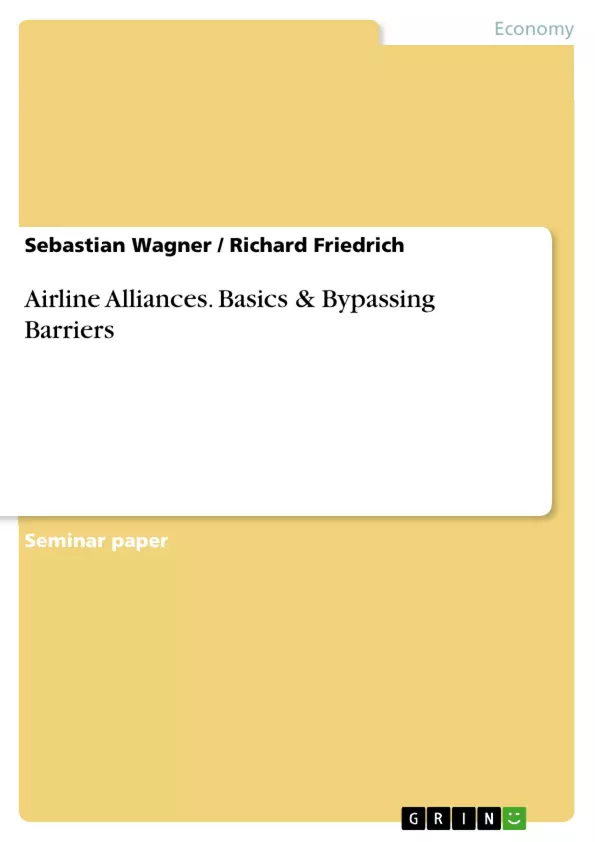The formation of modern airline alliances has been a key process and prominent tradition in the airline industry since the last three decades. The characteristics of these alliances vary in scopes and extend from branding or franchising of low density feeder or regional routes to the creation of global
airline networks conducted by the world’s most powerful carriers. Due to various reasons airliners prefer the amenities of acting co-operative rather than competitive relationships. Overall, it is undeniable that the formation and the rapid growth of alliances has been a central topic of the airline industry. Meanwhile it is scientifically proven that the economical benefits
and opportunities for airlines prevail possible threats and disadvantages.
This project paper intends to give a detailed description of present alliance landscape and competition connected with chosen statistical data in the beginning. Furthermore the key competitive effects and motivations leading the formation of alliances are described and act as basis for this project paper. This is followed by a concise overview about the mentioned regulations relating to bilateral air service agreements and M&A in aviation industry.
Based on that we will describe how the participation in an airline alliance can help to circumvent several constraints imposed by the current regulatory system. Finally the paper is closing with a critical look at the question whether airlines are airline alliances are the really the second best solutions or even sometimes intentionally chosen by the operators.
Inhaltsverzeichnis (Table of Contents)
- 1 Introduction
- 2 General Aspects of Airline Alliances
- 2.1 Present Airline Alliance Environment
- 2.2 Motivations and Benefits Leading to Alliances.
- 3 Bypassing Merger & Acquisition Regulations.
- 3.1 Regulations.....
- 3.2 Nationality....
- 4 Bypassing Bilateral Agreements.
- 5 Summary and Outlook
Zielsetzung und Themenschwerpunkte (Objectives and Key Themes)
This project paper aims to provide a comprehensive overview of the current airline alliance landscape, focusing on the competitive effects and motivations behind their formation. It examines the regulatory environment of the international air transport industry, particularly the constraints imposed by bilateral air service agreements and merger regulations. The paper then explores how participation in an airline alliance can help to circumvent these regulations, ultimately evaluating whether alliances are the most effective strategies for airlines.
- The present airline alliance environment and its competitive landscape
- Key motivations and benefits of airline alliances
- Regulatory barriers in the aviation industry, including bilateral air service agreements and M&A regulations
- Strategies for bypassing regulatory constraints through airline alliances
- The effectiveness of airline alliances as a strategic approach for airlines
Zusammenfassung der Kapitel (Chapter Summaries)
- Chapter 1: Introduction This chapter introduces the topic of airline alliances, emphasizing their significant role in the aviation industry over the past three decades. It highlights the various reasons why airlines prefer cooperative relationships over competition, emphasizing the economic benefits and opportunities that alliances present. The chapter also explores the regulatory environment of the international air transport industry, highlighting the challenges posed by restrictive bilateral air service agreements and merger regulations, and how airlines often attempt to bypass these regulations to increase their influence and gain access to new markets.
- Chapter 2: General Aspects of Airline Alliances This chapter delves into the evolution and current state of airline alliances, tracing their origins back to the mid-1970s. It examines the various types of alliances, from branding and franchising to the creation of global airline networks, highlighting the growth in size and depth of these alliances in recent years. The chapter further explores the expansion of alliances into the cargo sector, driven by existing regulatory barriers and foreign ownership restrictions. It provides statistical data and comparisons of the major global alliances, including Star Alliance, oneworld, and Skyteam.
Schlüsselwörter (Keywords)
Airline alliances, aviation industry, competitive effects, motivations, regulations, bilateral air service agreements, merger and acquisitions (M&A), regulatory constraints, global airline networks, strategic approach, international air transport.
- Citar trabajo
- Diplom-Kaufmann Sebastian Wagner (Autor), Richard Friedrich (Autor), 2013, Airline Alliances. Basics & Bypassing Barriers, Múnich, GRIN Verlag, https://www.grin.com/document/214125



